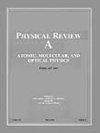Topological phase transition in fluctuating imaginary gauge fields
IF 2.6
2区 物理与天体物理
Q2 OPTICS
引用次数: 0
Abstract
We investigate the exact solvability and point-gap topological phase transitions in non-Hermitian lattice models. These models incorporate site-dependent nonreciprocal hoppings $J e^{\pm g_n}$, facilitated by a spatially fluctuating imaginary gauge field $ig_n \hat~x$ that disrupts translational symmetry. By employing suitable imaginary gauge transformations, it is revealed that a lattice characterized by any given $g_n$ is spectrally equivalent to a lattice devoid of fields, under open boundary conditions. Furthermore, a system with closed boundaries can be simplified to a spectrally equivalent lattice featuring a uniform mean field $i\bar{g}\hat~x$. This framework offers a comprehensive method for analytically predicting spectral topological invariance and associated boundary localization phenomena for bond-disordered nonperiodic lattices. These predictions are made by analyzing gauge-transformed isospectral periodic lattices. Notably, for a lattice with quasiperiodic $g_n= \ln |\lambda \cos 2\pi \alpha n|$ and an irrational $\alpha$, a previously unknown topological phase transition is unveiled. It is observed that the topological spectral index $W$ assumes values of $-N$ or $+N$, leading to all $N$ open-boundary eigenstates localizing either at the right or left edge, solely dependent on the strength of the gauge field, where $\lambda<2$ or $\lambda>2$. A phase transition is identified at the critical point $\lambda\approx2$, at which all eigenstates undergo delocalization. The theory has been shown to be relevant for long-range hopping models and for higher dimensions.波动虚规场中的拓扑相变
我们研究了非赫米提晶格模型的精确可解性和点隙拓扑相变。这些模型包含依赖于位点的非互易跳变 $J e^{\pm g_n}$,由空间波动的虚规场 $ig_n \hat~x$ 促进,它破坏了平移对称性。通过使用合适的虚规变换,可以发现在开放边界条件下,以任意给定的$g_n$为特征的晶格在光谱上等价于没有场的晶格。此外,具有封闭边界的系统可以简化为具有均匀平均场 $i\bar{g}\hat~x$ 的光谱等价晶格。这个框架提供了一种全面的方法,用于分析预测键异序非周期性晶格的谱拓扑不变性和相关的边界局部化现象。这些预测是通过分析规规变换的等谱周期晶格得出的。值得注意的是,对于具有准周期性$g_n= \ln |\lambda \cos 2\pi \alpha n|$和非理性$\alpha$的晶格,揭示了一种以前未知的拓扑相变。据观察,拓扑谱指数 $W$ 取值为 $-N$ 或 $+N$,这导致所有 $N$ 开界特征状态要么定位在右边缘,要么定位在左边缘,而这完全取决于规纳场的强度,其中 $\lambda2$。在临界点$\lambda\approx2$处会出现相变,此时所有特征状态都会发生脱局域化。该理论已被证明与长程跳跃模型和更高维度相关。
本文章由计算机程序翻译,如有差异,请以英文原文为准。
求助全文
约1分钟内获得全文
求助全文
来源期刊

Physical Review a
OPTICSPHYSICS, ATOMIC, MOLECULAR & CHEMICA-PHYSICS, ATOMIC, MOLECULAR & CHEMICAL
CiteScore
5.30
自引率
24.10%
发文量
2086
期刊介绍:
Physical Review A (PRA) publishes important developments in the rapidly evolving areas of atomic, molecular, and optical (AMO) physics, quantum information, and related fundamental concepts.
PRA covers atomic, molecular, and optical physics, foundations of quantum mechanics, and quantum information, including:
-Fundamental concepts
-Quantum information
-Atomic and molecular structure and dynamics; high-precision measurement
-Atomic and molecular collisions and interactions
-Atomic and molecular processes in external fields, including interactions with strong fields and short pulses
-Matter waves and collective properties of cold atoms and molecules
-Quantum optics, physics of lasers, nonlinear optics, and classical optics
 求助内容:
求助内容: 应助结果提醒方式:
应助结果提醒方式:


